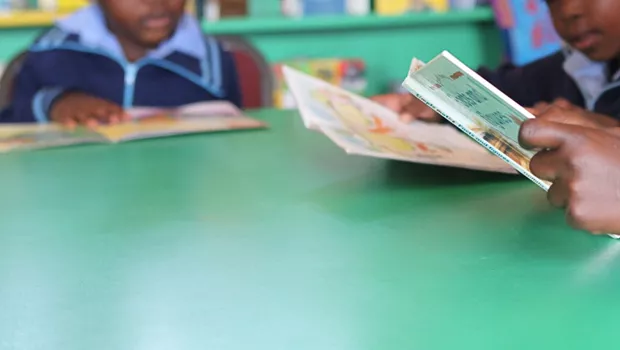 Read "Yă’s Backyard Jungle"
Read "Yă’s Backyard Jungle"
Room to Read’s Quality Reading Materials (QRM) team, along with the help of translators, have been working to translate our Peace & Equality Book Collection into Jarai, a local language of the Montagnard Jarai people, and a minority language in Vietnam and Cambodia. Author H'Abigail Mlo, who wrote “Ya’s Backyard Jungle” for the collection, wanted her book to be translated into Jarai, in addition to Vietnamese, so that young Montagnard readers can enjoy the book.
Originally from the Central Highlands of Vietnam, H'Abigail’s parents and maternal grandparents immigrated from refugee camps in Thailand and the Philippines to North Carolina in the 1980s. H’Abigail now lives in Greensboro, North Carolina, home to the largest population of Montagnards outside of Southeast Asia. Today, H’Abigail is an author committed to telling the stories of Montagnard people.
Once our QRM team translated “Ya’s Backyard Jungle,” they decided to translate the entire Peace & Equality series into Jarai so that Montagnard communities around the world can enjoy all the stories. The full collection of Jarai books will be available on Literacy Cloud in September.
Publishing storybooks in minority languages is a key part of keeping local languages and traditions alive for future generations. Room to Read’s expertise working with local authors, illustrators, publishers and printers to develop high-quality books quickly to meet specific community needs, irrespective of profitability, makes the organization particularly well-suited to tackle the lack of diversity and accessibility to high-quality children’s books in minority language communities.
We recently spoke to Room to Read staff members from our Literacy Program who have worked with minority language communities in order to gain greater insight on the importance of minority language book publishing.

Associate Director, Literacy, Patrick Curry
Many minority-language communities tend to have limited access to child-friendly storybooks in their language. As a result, children in these communities often have few, if any, opportunities to engage with books and other reading materials that they can understand and enjoy. Without this access and exposure, it can be very difficult for children to develop basic reading skills, let alone a love and habit of reading. To compound the problem, if children are eager to read but only have access to books written in an unfamiliar language with illustrations, characters, settings and events that do not reflect their lives, their first experiences reading can be demotivating and uninspiring. Imagine how frustrating it’d be to try to learn to read using a book written in an unfamiliar language about un-relatable characters and events!
By publishing children’s books in minority languages, Room to Read fills a key gap in the supply chain and helps to ensure that children in minority language communities have significantly more access to fun storybooks that they can understand and relate to. Ultimately, this increased access translates to more opportunities for these children to develop a love and habit of reading.
Of course, Room to Read realizes that increasing the supply of quality reading materials in minority languages is just one side of the equation. To help communities build strong reading cultures, which can promote greater demand for child-friendly storybooks, Room to Read works closely to engage schools and communities in events and activities designed to promote and celebrate reading, including reading festivals, International Literacy Day celebrations, library and reading instruction training, parent-teacher meetings and more.
 Illustration from local story, “The Play”
Illustration from local story, “The Play”
Program Manager, Literacy, South Asia, Nivrita Durgvanshi
In India, where communities are often multilingual, many children start primary school with a limited understanding of the school languages used as a medium of instruction. The languages spoken by children at home tend to have no space in the classroom or curriculum, which means children find it difficult to comprehend what is said by a teacher. This creates a barrier in the process of building literacy skills and often becomes a reason for children to drop out of school. According to a 2019 UNESCO report, “students who do not speak the dominant language are at a higher risk of dropping out of school or leaving without having learned much at all.”
This is why Room to Read initiated a program for linguistic-minority children in 100 schools of the Sirohi district of Rajasthan. In these schools, the school language is Hindi and the students speak Adivasi, Garasiya and Marwadi. The program aims to bring teachers and students together to create a collaborative, interactive space for a smooth transition from the children’s home language to the school language.
One of the key strategies of the program is to provide context-specific storybooks in the children’s language and train teachers to use these books as a resource to bridge language gaps. In the initial phase, a teacher uses local-language books for read-aloud sessions in the students' language and encourages students to express thoughts and ideas in their local language. Using the same books, the teacher gradually begins to use two languages — the students’ language as well as the school language — which helps the students understand the stories in their school language. Finally, the teacher slowly increases the usage of the school language to help students learn the school language. The presence of minority language books in a classroom not only supports children academically but also acknowledges their linguistic and social identity in a learning space that has been neglected for too long a time.
Associate Director, Literacy, Africa, Titus Kazungu
Minority language communities have generally been subjected to a myriad of challenges. These include historical injustices, human rights abuses and resource deficiencies. Education opportunities, in general, have been scarce, and teaching and learning materials, including storybooks, tend to be in languages that are both unfamiliar and foreign to minority language speakers.
Room to Read’s commitment to developing books for minority language communities helps address human rights issues. By providing books in a student’s local language, Room to Read seeks to address issues around diversity and inclusivity, as well as social justice. This is important because when children see themselves and their stories in books, they feel affirmed in their identity which promotes a positive self-image and outlook. These books show students that the language, culture and lives of the speakers of the minority language are both respected and valued.
Writing children’s books in minority languages is critical at a time when many local languages are near extinction. By creating children’s storybooks in these languages, the young learn to read, write and speak their local languages, thus preserving the language, culture and traditional knowledge. Therefore, books in minority languages should not just focus on fiction stories but also careful documentation of cultural knowledge through the publishing of relevant nonfiction texts.



